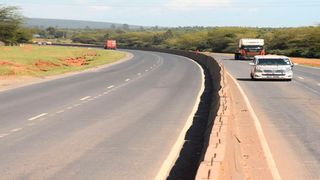
A section of the 11-kilometre stretch of the famous Sachang’wan black spot along the Nakuru-Eldoret highway.
| Boniface Mwangi | Nation Media GroupNews
Premium
How 'magic wall' helped tame accidents on the Salgaa-Sachangwan route
What you need to know:
- A concrete barrier, christened the ‘magic wall of China’, was erected in the middle of the road, preventing vehicles from crashing into oncoming traffic on either side of the road.
- Rift Valley Regional Commissioner Dr Abdi Hassan said the ‘magic wall’, erection of bumps and marking of the road stretch have ended the mass deaths.
For many years, Mr Joseph Chepkwony, a resident of Sachang’wan, was among the first responders to accidents happening on the notorious Salgaa-Sachang’wan stretch on the Nakuru-Eldoret highway.
The more than 20-kilometre stretch was perhaps the most notorious blackspot in the country.
Chepkwony says the mere mention of Salgaa or Sachang’wan could send a chill down the spine of every motorist and traveller who frequently used the busy Nakuru-Eldoret highway.
“Among the superstitious beliefs people held was that the spirits of the nearly 200 people who died in the 2009 Sachang’wan fire tragedy and are buried in a mass grave next to the road were hovering around baying for the blood of travellers,” Chepkwony says.
But on April 24, 2018, the Kenya National Highways Authority (Kenha) contracted the China Railway Number 10 company to convert the section into a dual carriageway.
A concrete barrier, which locals have christened the ‘magic wall of China’, was also erected in the middle of the road, preventing vehicles from crashing into oncoming traffic on either side of the road.
“The wall was like magic that ended the road carnage along the stretch,” Mr Chepkwony says.
“The accidents normally involved long distance trucks and public service vehicles. The screeching of brakes and bangs that often woke me up are gone,” adds the 43-year-old plumber.
Rift Valley Regional Commissioner Dr Abdi Hassan said the ‘magic wall’, erection of bumps and marking of the road stretch have ended the mass deaths.
“Most of the accidents resulted from truck drivers losing control after freewheeling. The government is determined to ensure road carnage along the highway and others in the region is curbed,” he says.
However, there is a new nightmare for travellers along the Nakuru-Eldoret highway. The Ngata bridge-Sobea-Salgaa stretch is now the new accident blackspot.
Here, death lurks.
Statistics from the Rongai-based Road Traffic Accident department show the Sobea-Salgaa section claims at least five lives every month.
Police and the National Transport and Safety Authority have blamed most of the accidents on speeding and careless overtaking.
“The landscape between Ngata-Sobea and Salgaa stretch is relatively flat. This kind of terrain has been noted to give road users an easy time in driving, making it a possibility to lose concentration,”says Mr Charles Ombati, a first responder at crash scenes along the route.
“Most of the accidents occur at night and are attributed to human error; speeding and overtaking. Motorists using the route must be cautious to save lives,”he adds.
Not even pupils from the nearby Ngata Primary and Crater View Academy have been spared.
A few months ago, two pupils were hit by a speeding 14-seater matatu and left to nurse injuries.
Design flaws, vandalism of road signs and reckless driving have made the section, which connects the capital Nairobi to Western Kenya, a death trap.
In the past 10 months alone, at least 20 lives have been lost along the stretch and dozens injured.
Pedestrians are also knocked in hit-and-run accidents.
Residents are now appealing to the Kenya National Highways Authority to erect bumps and road signs along the stretch.
Mr Ben Omwandho,the chairman of the Green Estate in Ngata, says hardly two days pass without an accident involving a pedestrian.
“We want the government to erect speed bumps and other crucial road signs on the stretch to reduce accidents and prevent deaths. We have lost very many lives since the year begun.”
He blames most of the accidents on speeding. “Even as we wait for the much awaited Sh160 billion upgrade of the Rironi-Mau Summit highway,something must be done to tame the accidents,”says Mr Omwandho.
His sentiments were echoed by Mr Steve Rono,a youth leader, who said a footbridge and speed bumps would significantly reduce accidents.
“From January this year, we have lost a lot of people here. We can’t continue losing more lives,” says Mr Rono.
This is what has prompted the government, through Kenha, to embark on erecting a concrete barrier along a four-kilometre stretch of the Ngata-Salgaa stretch. The upgrade of the road started this month.
Mr William Odhiambo, a contracted surveyor, said the work will include erection of a dual carriageway, installation of barriers, as well as installation of a warning and informative road signs.
“The upgrade of the section has started,” he says.





